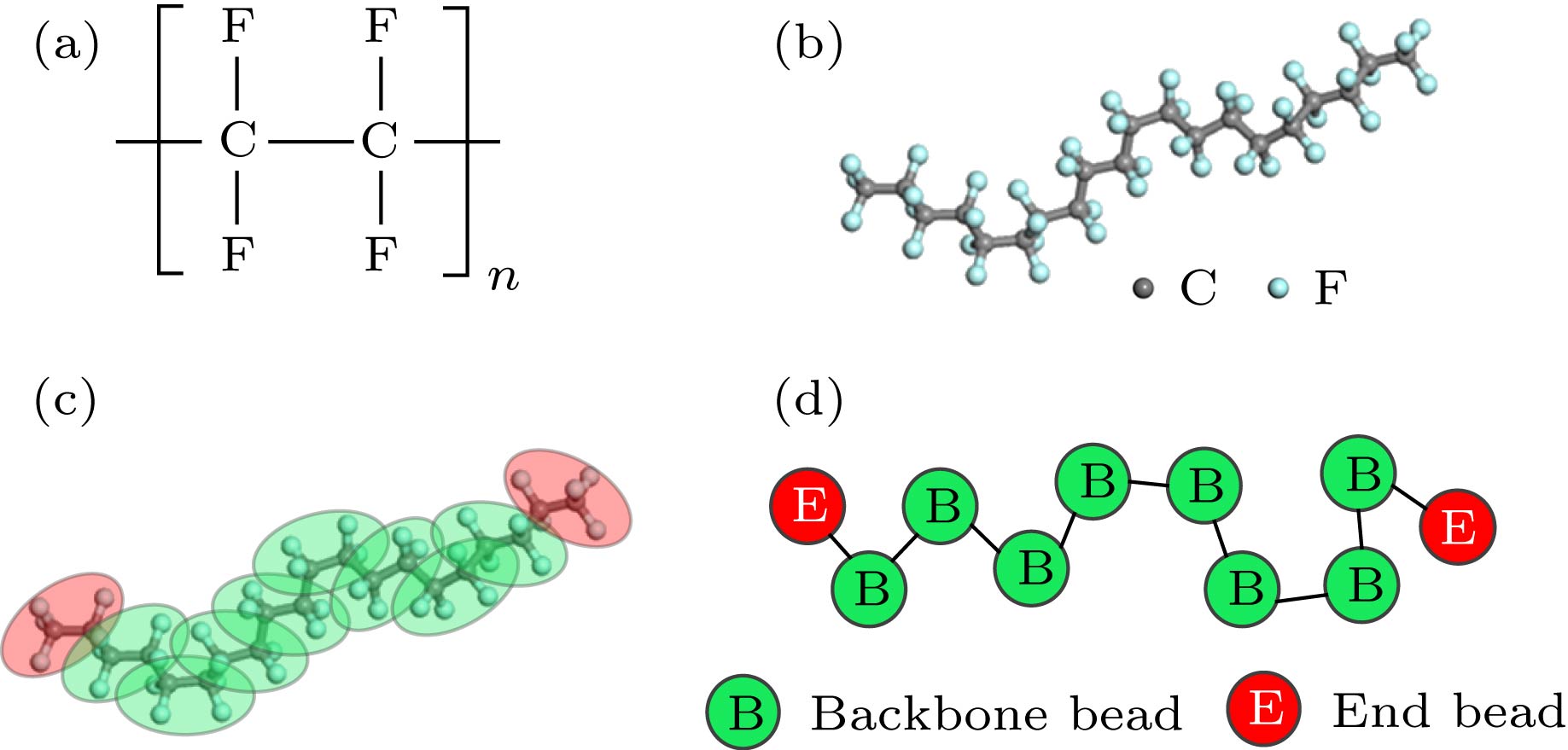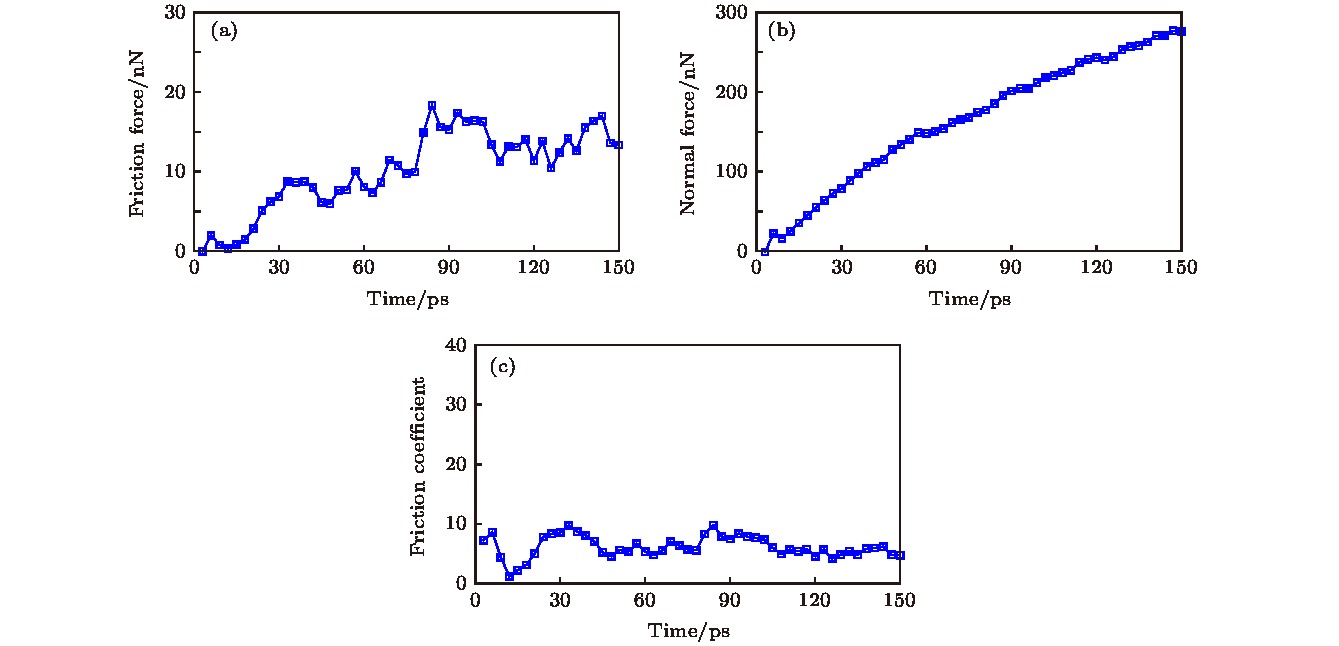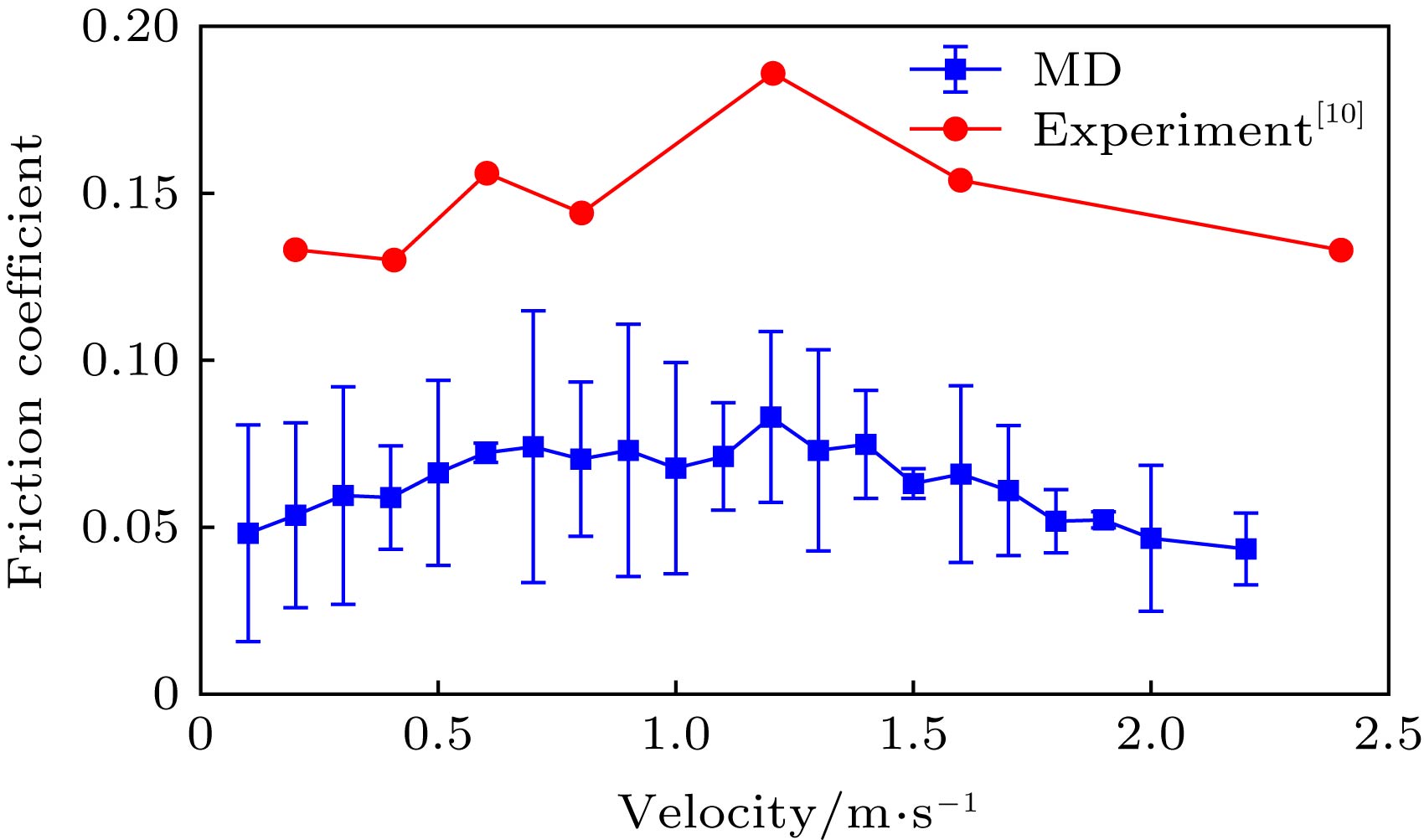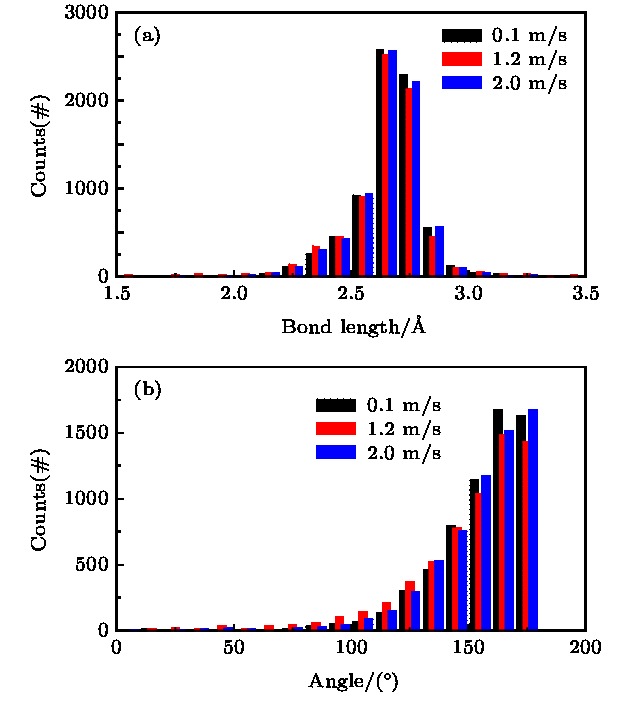-
Velocity is an important factor affecting the friction coefficient of polymers. Polytetrafluoroethylene (PTFE), as a typical self-lubricating polymer, has attracted extensive attention because of its low friction coefficient. Currently, the friction coefficient of PTFE is investigated usually by using experimental method. The experimental study which is limited by the functionality and precision of the apparatus is inaccessible to the exploration of the microscopic tribological mechanism of PTFE. Therefore, the coarse-grained molecular dynamics simulation method is adopted in this study. In the coarse-grained model, one PTFE molecule is simplified into ten beads, including two end beads and eight backbone beads. The non-bonding and bonding interactions between beads are described by using Lennard-Jones (L-J) and multi-centered Gaussian-based potential. In order to investigate the effect of velocity on the friction coefficient of PTFE at an atomic level, we build a two-layer PTFE friction model by using the coarse-grained molecular dynamics simulation method. To directly compare the experimental results with the simulation results, we set the value of the externally applied load and the range of the velocities that match each other as closely as possible. The mechanism of how the velocity affects PTFE friction coefficient is obtained at an atomic level through analyzing the bond length distribution, bond angle distribution, the deformation of the bottom PTFE molecules within the contact area, and the friction force and normal force as a function of simulation time. The simulation results show that the bond length and bond angle decrease, the deformation of the bottom PTFE molecules along the x-direction and the friction force increase with velocity increasing. This is because the bounce back caused by the deformed PTFE molecules enhances the friction force. The severer the deformation, the larger the friction force will be. However, when the velocity exceeds a critical velocity, the bond length and bond angle increase, the deformation of the bottom PTFE molecule and the friction force decrease with velocity increasing. This is most likely due to the fact that the bottom PTFE molecules within the contact area tend to tilt along the moving direction of the upper PTFE layer, thereby reducing the angle between the upper and the bottom PTFE molecules to an angle close to the angle of parallel sliding, finally resulting in the decrease of the friction force. The deformations of PTFE molecules along the z-direction are nearly invariable under different velocities. This corresponds to the variation of the normal force. Therefore, for a constant externally applied load, the friction coefficient first increases then decreases with velocity increasing. In addition, the critical velocity is 1.2 m/s, which is in line with the published experimental result. -
Keywords:
- polytetrafluoroethylene /
- friction /
- velocity /
- molecular dynamics simulation
[1] Tian K, Goldsby D L, Carpick R W 2018 Phys. Rev. Lett. 120 186101
 Google Scholar
Google Scholar
[2] Dong Y, Duan Z, Tao Y, Wei Z, Gueye B, Zhang Y, Chen Y 2019 Tribol. Int. 136 259
 Google Scholar
Google Scholar
[3] 董赟, 段早琦, 陶毅, Gueye Birahima, 张艳, 陈云飞 2019 68 016801
 Google Scholar
Google Scholar
Dong Y, Duan Z Q, Tao Y, Gueye B, Zhang Y, Chen Y F 2019 Acta Phys. Sin. 68 016801
 Google Scholar
Google Scholar
[4] Li Q, Dong Y, Perez D, Martini A, Carpick R W 2011 Phys. Rev. Lett. 106 126101
 Google Scholar
Google Scholar
[5] Sharma N, Kumar N, Dash S, Tyagi A K 2012 AIP Conf. Proc. 1447 651
[6] Sun F, Hou Y, Wang L, Huang L, Qian Z 2017 Int. J. Pave. Res. Tech. 10 343
 Google Scholar
Google Scholar
[7] Lin L, Pei X Q, Bennewitz R, Schlarb A K 2018 Tribol. Int. 122 108
 Google Scholar
Google Scholar
[8] Xiong X 2018 Ind. Lubr. Tribol. 70 273
 Google Scholar
Google Scholar
[9] Barry P R, Jang I, Perry S S, Sawyer W G, Sinnott S B, Phillpot S R 2007 J. Computer-Aided Mater. Des. 14 239
 Google Scholar
Google Scholar
[10] Yuan X D, Yang X J 2010 Wear 269 291
 Google Scholar
Google Scholar
[11] Harris K L, Pitenis A A, Sawyer W G, Krick B A, Blackman G S, Kasprzak D J, Junk C P 2015 Macromolecules 48 3739
 Google Scholar
Google Scholar
[12] 杨学宾, 晋欣桥, 杜志敏, 崔天生, 杨绍侃 2010 内燃机工程 31 105
 Google Scholar
Google Scholar
Yang X B, Jin X Q, Du Z M, Cui T S, Yang S K 2010 Chin. Int. Combu. Engine. Eng. 31 105
 Google Scholar
Google Scholar
[13] 郭丰镐 1981 机械工程材料 4 5
Guo F G 1981 Mater. Mech. Eng. 4 5
[14] 黄传辉 2008 徐州工程学院学报(自然科学版) 23 7
 Google Scholar
Google Scholar
Huang C H 2008 Xuzhou Inst. Technol. (Natural Sciences Edition)
23 7  Google Scholar
Google Scholar
[15] 马姗, 马军, 杨光参 2016 65 148701
 Google Scholar
Google Scholar
Ma S, Ma J, Yang G C 2016 Acta Phys. Sin. 65 148701
 Google Scholar
Google Scholar
[16] Ewen J P, Heyes D M, Dini D 2018 Friction 6 349
 Google Scholar
Google Scholar
[17] Dong Y, Li Q, Martini A 2013 J. Vac. Sci. Technol. A 31 030801
[18] Dong Y, Wang F, Zhu Z, He T 2019 AIP Adv. 9 045213
 Google Scholar
Google Scholar
[19] Barry P R, Chiu P Y, Perry S S, Sawyer W G, Sinnott S B, Phillpot S R 2015 Tribol. Lett. 58 50
 Google Scholar
Google Scholar
[20] Barry P R, Chiu P Y, Perry S S, Sawyer W G, Phillpot S R, Sinnott S B 2009 J. Phys.: Condens. Matter 21 144201
 Google Scholar
Google Scholar
[21] Chiu P Y, Barry P R, Perry S S, Sawyer W G, Phillpot S R, Sinnott S B 2011 Tribol. Lett. 42 193
 Google Scholar
Google Scholar
[22] 王曦, 黎明, 叶方富, 周昕 2017 66 150201
 Google Scholar
Google Scholar
Wang X, Li M, Ye F F, Zhou X 2017 Acta Phys. Sin. 66 150201
 Google Scholar
Google Scholar
[23] Hagita K, Morita H, Doi M, Takano H 2016 Macromolecules 49 1972
 Google Scholar
Google Scholar
[24] Thota N, Luo Z, Hu Z, Jiang J 2013 J. Phys. Chem. B 117 9690
 Google Scholar
Google Scholar
[25] Zuo Z, Yang Y, Qi X, Su W, Yang X 2014 Wear 320 87
 Google Scholar
Google Scholar
[26] Milano G, Mü1ller P F 2005 J. Phys. Chem. B 109 18609
 Google Scholar
Google Scholar
[27] Milano G, Goudeau S, Mü1ller P F 2005 J. Polym. Sci. Pol. Phys. 43 871
 Google Scholar
Google Scholar
[28] Pan D, Liu C, Qi X, Yang Y, Hao X 2019 Tribol. Int. 133 32
 Google Scholar
Google Scholar
[29] Onodera T, Nunoshige J, Kawasaki K, Adachi K, Kurihara K, Kubo M 2017 J. Phys. Chem. C 121 14589
 Google Scholar
Google Scholar
[30] Plimpton S 1995 J. Comp. Physiol. 117 1
 Google Scholar
Google Scholar
[31] Jang I, Burris D L, Dickrell P L, Barry P R, Santos C, Perry S S, Phillpot S R, Sinnott S B, Sawyer W G 2007 J. Appl. Phys. 102 123509
 Google Scholar
Google Scholar
-
Bond type nb i Abi wbi/Å lbci/Å B-B/B-E 2 1 0.3 0.15 2.7 2 0.03 0.2 2.5 Angle type na i Aai wai/(°) θaci/(°) B-B-B/B-B-E 3 1 1.44 30 180 2 1.66 12 180 3 0.12 29 145 -
[1] Tian K, Goldsby D L, Carpick R W 2018 Phys. Rev. Lett. 120 186101
 Google Scholar
Google Scholar
[2] Dong Y, Duan Z, Tao Y, Wei Z, Gueye B, Zhang Y, Chen Y 2019 Tribol. Int. 136 259
 Google Scholar
Google Scholar
[3] 董赟, 段早琦, 陶毅, Gueye Birahima, 张艳, 陈云飞 2019 68 016801
 Google Scholar
Google Scholar
Dong Y, Duan Z Q, Tao Y, Gueye B, Zhang Y, Chen Y F 2019 Acta Phys. Sin. 68 016801
 Google Scholar
Google Scholar
[4] Li Q, Dong Y, Perez D, Martini A, Carpick R W 2011 Phys. Rev. Lett. 106 126101
 Google Scholar
Google Scholar
[5] Sharma N, Kumar N, Dash S, Tyagi A K 2012 AIP Conf. Proc. 1447 651
[6] Sun F, Hou Y, Wang L, Huang L, Qian Z 2017 Int. J. Pave. Res. Tech. 10 343
 Google Scholar
Google Scholar
[7] Lin L, Pei X Q, Bennewitz R, Schlarb A K 2018 Tribol. Int. 122 108
 Google Scholar
Google Scholar
[8] Xiong X 2018 Ind. Lubr. Tribol. 70 273
 Google Scholar
Google Scholar
[9] Barry P R, Jang I, Perry S S, Sawyer W G, Sinnott S B, Phillpot S R 2007 J. Computer-Aided Mater. Des. 14 239
 Google Scholar
Google Scholar
[10] Yuan X D, Yang X J 2010 Wear 269 291
 Google Scholar
Google Scholar
[11] Harris K L, Pitenis A A, Sawyer W G, Krick B A, Blackman G S, Kasprzak D J, Junk C P 2015 Macromolecules 48 3739
 Google Scholar
Google Scholar
[12] 杨学宾, 晋欣桥, 杜志敏, 崔天生, 杨绍侃 2010 内燃机工程 31 105
 Google Scholar
Google Scholar
Yang X B, Jin X Q, Du Z M, Cui T S, Yang S K 2010 Chin. Int. Combu. Engine. Eng. 31 105
 Google Scholar
Google Scholar
[13] 郭丰镐 1981 机械工程材料 4 5
Guo F G 1981 Mater. Mech. Eng. 4 5
[14] 黄传辉 2008 徐州工程学院学报(自然科学版) 23 7
 Google Scholar
Google Scholar
Huang C H 2008 Xuzhou Inst. Technol. (Natural Sciences Edition)
23 7  Google Scholar
Google Scholar
[15] 马姗, 马军, 杨光参 2016 65 148701
 Google Scholar
Google Scholar
Ma S, Ma J, Yang G C 2016 Acta Phys. Sin. 65 148701
 Google Scholar
Google Scholar
[16] Ewen J P, Heyes D M, Dini D 2018 Friction 6 349
 Google Scholar
Google Scholar
[17] Dong Y, Li Q, Martini A 2013 J. Vac. Sci. Technol. A 31 030801
[18] Dong Y, Wang F, Zhu Z, He T 2019 AIP Adv. 9 045213
 Google Scholar
Google Scholar
[19] Barry P R, Chiu P Y, Perry S S, Sawyer W G, Sinnott S B, Phillpot S R 2015 Tribol. Lett. 58 50
 Google Scholar
Google Scholar
[20] Barry P R, Chiu P Y, Perry S S, Sawyer W G, Phillpot S R, Sinnott S B 2009 J. Phys.: Condens. Matter 21 144201
 Google Scholar
Google Scholar
[21] Chiu P Y, Barry P R, Perry S S, Sawyer W G, Phillpot S R, Sinnott S B 2011 Tribol. Lett. 42 193
 Google Scholar
Google Scholar
[22] 王曦, 黎明, 叶方富, 周昕 2017 66 150201
 Google Scholar
Google Scholar
Wang X, Li M, Ye F F, Zhou X 2017 Acta Phys. Sin. 66 150201
 Google Scholar
Google Scholar
[23] Hagita K, Morita H, Doi M, Takano H 2016 Macromolecules 49 1972
 Google Scholar
Google Scholar
[24] Thota N, Luo Z, Hu Z, Jiang J 2013 J. Phys. Chem. B 117 9690
 Google Scholar
Google Scholar
[25] Zuo Z, Yang Y, Qi X, Su W, Yang X 2014 Wear 320 87
 Google Scholar
Google Scholar
[26] Milano G, Mü1ller P F 2005 J. Phys. Chem. B 109 18609
 Google Scholar
Google Scholar
[27] Milano G, Goudeau S, Mü1ller P F 2005 J. Polym. Sci. Pol. Phys. 43 871
 Google Scholar
Google Scholar
[28] Pan D, Liu C, Qi X, Yang Y, Hao X 2019 Tribol. Int. 133 32
 Google Scholar
Google Scholar
[29] Onodera T, Nunoshige J, Kawasaki K, Adachi K, Kurihara K, Kubo M 2017 J. Phys. Chem. C 121 14589
 Google Scholar
Google Scholar
[30] Plimpton S 1995 J. Comp. Physiol. 117 1
 Google Scholar
Google Scholar
[31] Jang I, Burris D L, Dickrell P L, Barry P R, Santos C, Perry S S, Phillpot S R, Sinnott S B, Sawyer W G 2007 J. Appl. Phys. 102 123509
 Google Scholar
Google Scholar
Catalog
Metrics
- Abstract views: 24133
- PDF Downloads: 228
- Cited By: 0















 DownLoad:
DownLoad:







